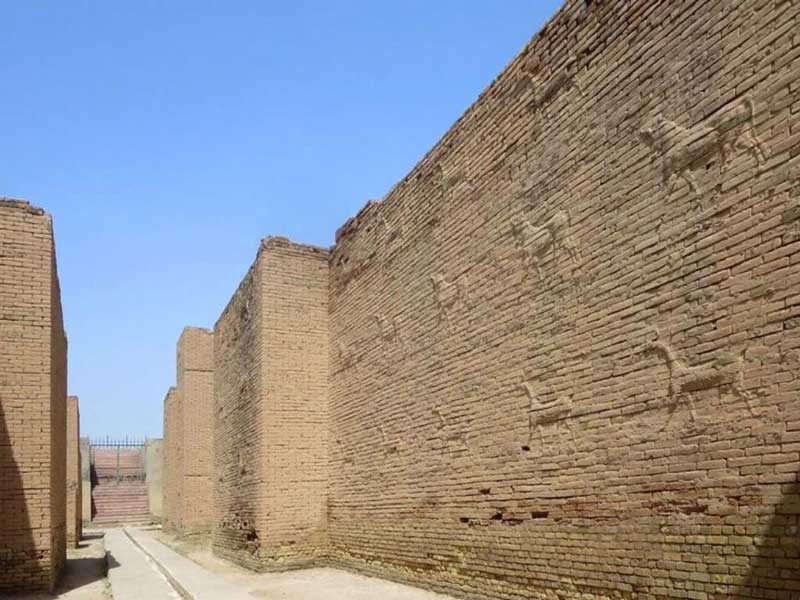
From the 18th to 6th centuries BC, Babylon was a key kingdom in ancient Mesopotamia. Located between the Tigris and the Euphrates, about 100 km south of Baghdad in modern-day Iraq, the ancient city of Babylon served for nearly two millennia as a centre of Mesopotamian civilization. The city of Babylon was largely rebuilt by King Nebuchadnezzar II, in the 6th Century BC. Under his rule (605 BC-562 BC) Babylon became one of the most splendid cities of the ancient world. With the intention to beautify the capital of his empire, he restored the temple of Marduk and built the famous Hanging Gardens, said to win the heart of his homesick wife, Amyitis.

Construction of the Ishtar Gate in about 575 BC was also a part of the beautification plan of King Nebuchadnezzar II. He constructed the brilliant Ishtar gate, the eighth gate of the city of Babylon, which marked the entrance to the city at the beginning of the Procession Street, the main thoroughfare used for the purpose of parades during new years’ celebrations. Since it was dedicated to the goddess Ishtar, the gate was named after her. However, apart from Ishtar, Nebuchadnezzar also paid homage to the other Babylonian deities through various animal representations along the Processional Way that led to the temple of Marduk.

The Ishtar Gate itself was a double one, nearly 50 feet high and 100 feet wide, with a vast antechamber in the southern side. The roof and doors were made of fine cedar, while the surrounding bricks were furnished with jewel-like blue enameled tiles, thought to be of lapis lazuli, adorned with bas-relief of lions, bulls and dragons.
Through the gatehouse was the ‘Processional Way’ that led to the temple of Marduk. It was a paved corridor of red and yellow bricks, rows of red stone on the outer layers and a yellow row in-between. Prayers from King Nebuchadnezzar to the chief god Marduk were inscribed underneath each of these stones. The corridor traced over half a mile, with walls over 15 m tall on each side. The walls were decorated with more than 120 images of lions, bulls, dragons, and flowers, made from enameled yellow and brown tiles. The sacred animals are symbolic representations of certain ancient deities. Lions were often associated with Ishtar, the goddess of love, sex, fertility and war; bulls (aurochs) with Adad, a weather god; and dragons with Marduk, the national god of Babylon. Every year, statues of the deities were paraded through the Ishtar Gate and down the Processional Way for the New Year's celebration.

With time, Babylon’s power declined and eventually the magnificent structures collapsed and vanished under hundreds of years of desert storms. After years of negligence, the brilliance of ancient Babylon was finally unearthed by a German archaeologist, Robert Koldewey. His excavation of Babylon lasted from 1899 until 1917, when the original foundation of the Ishtar gate was discovered. The excavated material was subsequently used in a reconstruction of the Ishtar Gate and the Processional Way. The reconstruction was ended in 1930 CE at the Pergamon Museum in Berlin, Germany.

However, due to insufficient space at the Pergamon Museum, the Ishtar Gate was not reconstructed to its original size. Originally, it was a double gate, but the museum used only the smaller one, the frontal part. The second gate is still in the storage. The door and the roof of the original were not rebuilt. A miniature version of the Ishtar gate was also built in Iraq under Saddam Hussein, at the entrance of a museum. However, that reconstruction was never completed due to war and consequent fall of Saddam.

Apart from the Pergamon Museum, several other museums in the world have also received small portions of the Ishtar Gate, which include the Istanbul Archaeology Museum, the Detroit Institute of Art, the Royal Ontario Museum, the Louvre in Paris, Munich's State Museum of Egyptian Art, New York's Metropolitan Museum of Art, the Oriental Institute of Chicago, and many others.



During 2003 and 2004, the American and Polish troops turned the vast area of the ancient city’s archaeological site into a military base, which even included a helicopter pad. The consequent damage, as estimated by a study by the British Museum was huge. The archaeological site, with an area of around 300,000 sq m, had been covered with gravel, which contaminated the unexcavated areas. Trenches had been dug by the troops into archaeological mounds. Heavy war vehicles broke the pavement of the Processional Way and even nine dragon figures on the Gate of Ishtar had also been damaged.
It is unfortunate that, after some 2,600 years of rough weather, war, plunder and negligence, finally a portion of the so called civilized people of the modern world has turned to be the worst enemy of their own ancient heritage.
